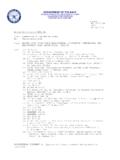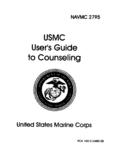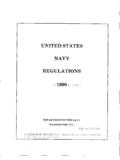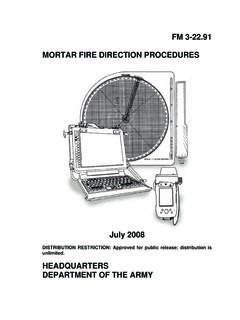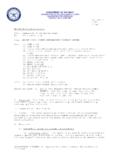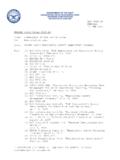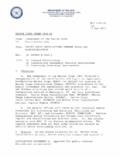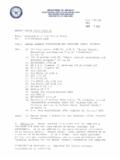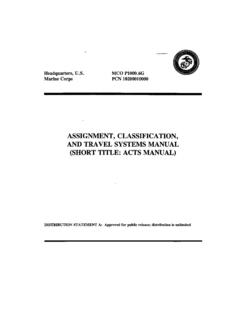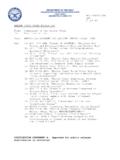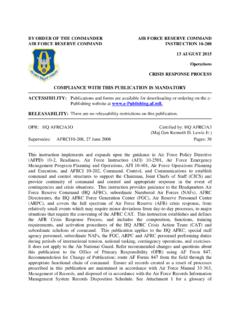Transcription of DEPARTMENT OF THE NAVY - marines.mil
1 DEPARTMENT OF THE NAVY. HEADQUARTERS UNITED STATES MARINE CORPS. 3000 MARINE CORPS PENTAGON. WASHINGTON DC 20350-3000. MCO TFSD. 18 Nov 2015. MARINE CORPS ORDER From: Commandant of the Marine Corps To: Distribution List Subj: TOTAL FORCE STRUCTURE PROCESS. Ref: See enclosure (1). Encl: (1) References (2) Total Force Structure Process Procedural Manual 1. Situation a. To provide policy and procedural guidance on the Total Force Structure Process (TFSP), per references (a) through (bk). The Deputy Commandant for Combat Development and Integration (DC. CD&I) is the Marine Air Ground Task Force (MAGTF) Integrator, with the authority, responsibility, and accountability for United States Marine Corps (USMC) Capabilities Based Assessment (CBA) Planning. Reference (c) establishes guidance for Services to follow in the conduct of integrated capabilities development.
2 The TFSP defines how the USMC develops integrated Force Structure Requirements which feed the USMC CBA process in support of the development of the USMC Enterprise Integration Plan (MCEIP). b. This Order establishes DC CD&I as the Total Force Structure Process Owner (TFSPO) and defines the policy, procedures, roles, responsibilities, and integration points across the enterprise for the management of the TFSP. The Total Force is defined as all units, billets (Marine, United States Navy (USN), and civilian) and equipment resident in the active component (AC) and the reserve component (RC). 2. Cancellation. Marine Corps Order DISTRIBUTION STATEMENT A: Approved for public release;. distribution is unlimited. MCO 18 Nov 2015. 3. Mission. The TFSPO, in conjunction with the Advocates, Operating Forces, and other USMC agencies, develops and maintains the USMC force structure and establishes the optimal allocation of resources in accordance with the Commandant of the Marine Corps' (CMC) priorities to provide a balanced and capable force.
3 The TFSPO plans and implements future force structure changes to build capability-based organizations which fulfill the Marine Corps' requirements and accomplishes the Mission Essential Tasks (METs) in accordance with reference (a). 4. Execution a. Commander's Intent and Concept of Operations (1) Commander's Intent. The TFSP will integrate decisions pertaining to unit, billet (active, reserve, USN, and civilian) and equipment requirements (Approved Acquisition Objective (AAO)) to develop and document force structure for the USMC. (2) Concept of Operations (a) The TFSP is a dynamic, non-linear process which provides a framework of understanding for developing and maintaining force structure. The TFSP transforms strategic guidance, policy constraints, and commander-generated recommendations into the integrated capabilities required to execute USMC missions.
4 The TFSP relies on a detailed, integrated examination of Doctrine, Organization, Training/Education, Materiel, Leadership/Communication Synchronization, Personnel, Facilities, and Cost (DOTMLPF&C), ensuring no aspect of the enterprise is ignored when new requirements for the USMC are identified, either from the top- down or from the bottom-up. This process is separate from the Joint Capabilities Integration and Development System (JCIDS). process which is the basis for capabilities development and the USMC CBA process. (b) Force structure represents the total requirement in terms of units, billets, and items of equipment necessary to accomplish USMC METs. The requirement then, acts as a catalyst and initiator in providing the USMC the actual capabilities required for each unit to perform its wartime mission, provides for strategic prepositioning of assets, and ensures sustainability of the total force.
5 The current force structure 2. MCO 18 Nov 2015. requirements lay the foundation for planning, programming, budgeting and execution (PPBE). (c) The TFSP is described in detail in enclosure (2). to this Order, the TFSP Procedural Manual. This Manual is divided into 12 chapters which define and establish policy for the conduct of the TFSP, explains the elements and components of force structure, describes the development, planning, and maintenance of force structure, and other key components/procedures of the process. The TFSP Procedural Manual is considered directive in nature with regard to the TFSP. and provides a greatly amplified version of this Order's concept of operations (CONOPS). b. Subordinate Element Missions (1) DC CD&I/CG Marine Corps Combat Development Command (MCCDC) (SUPPORTED AGENT). (a) As the TFSPO and the AAO process owner, own and manage USMC Total Force Structure (TFS) by coordinating the interests of all TFSP participants and facilitating the development and documentation of force structure.
6 (b) Coordinate and execute the following TFS. reviews: 1. Force Structure Review (FSR). A Service- level review conducted at the discretion of the CMC. A FSR is typically directed as a result of major Service-level issues such as end strength or capability changes. The FSR is chaired by the Director (Dir) Capabilities Development Directorate and supported by the CD&I Total Force Structure Division (TFSD), with Executive Steering Group (ESG) oversight led by the Assistant Commandant of the Marine Corps (ACMC). 2. Force Optimization Review (FOR). A biennial review designed to optimize the current and future planned force, taking into consideration new and emerging requirements. The FOR is chaired by the DC CD&I (TFSD) with ESG oversight, led by the Dir Capabilities Development Directorate. 3. Civilian Uncompensated Review Board (CURB).
7 The CURB convenes annually prior to Program Objective Memorandum (POM) cycle Program Reviews to validate, prioritize, price and incorporate new uncompensated civilian personnel requirements into the formal POM process. The CURB also convenes as needed . 3. MCO 18 Nov 2015. for off-cycle, time-sensitive requirements. The CURB is chaired by DC CD&I (TFSD). 4. Active Reserve (AR) Structure Review. A. biennial review designed to validate and prioritize AR structure requirements ensuring the AR structure supports the current and future planned force. The AR Structure Review will be chaired by DC CD&I (TFSD). 5. Individual Mobilization Augmentee (IMA). Structure Review. A biennial review designed to validate and prioritize Reserve IMA requirements ensuring the Reserve IMA. structure supports the current and future planned force.
8 The IMA Structure Review will be chaired by the DC CD&I (TFSD). 6. Approved Acquisition Objective (AAO), Table of Equipment (T/E) Review. A biennial review designed to validate and reconcile total force equipment requirements. Validation and reconciliation coincides with FSR/FOR actions as well as day-to-day management of equipment requirements for a given Table of Authorized Materiel Control Number (TAMCN). throughout its lifecycle. The AAO & T/E Reviews are chaired by the Dir, Capabilities Development Directorate. (c) Provide oversight of the command level Strategic Total Force Management Planning (STFMP) Process. Monitor the submission of the Total Force Action Plan (TFAP) submitted by commanders as a result of the STFMP. Provide the TFAP to the appropriate stakeholders for analysis. (d) Using manning control input concerning patients, prisoners, training and transients (P2T2) impacts, assess the need to adjust the training load to meet force structure targets across the Future Years Defense Program (FYDP).
9 Outputs may include training load adjustments assigned to Training and Education Command (TECOM). (e) Chair the Total Force (TF) DOTMLPF&C Working Group (WG). As Chair, integrate materiel and non-materiel solutions to capability gaps across all of the DOTMLPF&C pillars and develop DOTMLPF&C WG assessments of all force structure initiatives. This includes integrating and assessing all TFS. Reviews to ensure all recommendations are fully integrated across the Total Force. Present the solutions and their implementation implications to the Marine Requirements Oversight Council (MROC) for decision. 4. MCO 18 Nov 2015. (f) Serve as the CMC's subject matter expert (SME). on the following TF DOTMLPF&C pillars: Doctrine, Organization, Training/Education, Materiel (new capabilities), and materiel small m , increases, re-allocates, or decreases existing capabilities.
10 (g) Serve as the executive agent for all force structure-related adjudication, planning, development, and evaluation in support of the USMC and force structure initiatives directed by Congress, the Secretary of Defense (SECDEF), the Office of the Secretary of Defense (OSD), or the Secretary of the Navy (SECNAV). (h) Publish the TFSP and all orders and directives pertaining to: 1. Reference (l). 2. Reference (n). 3. Reference (p). 4. Reference (q). 5. Reference (r). 6. Reference (v). 7. Reference (bi). 8. Reference (bj). 9. Reference (bk). 10. MCBul 5400 (directs the activation, deactivation, re-designation, reorganization, or relocation of units). (i) Serve as the central Headquarters Marine Corps (HQMC) agency responsible for the oversight and standardized training of all Occupational Field (OccFld) Managers and Military Occupational Specialty (MOS) Specialists in the USMC.
